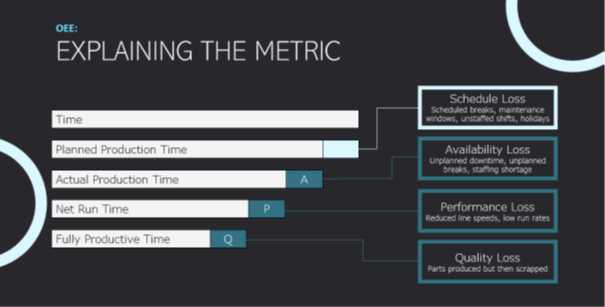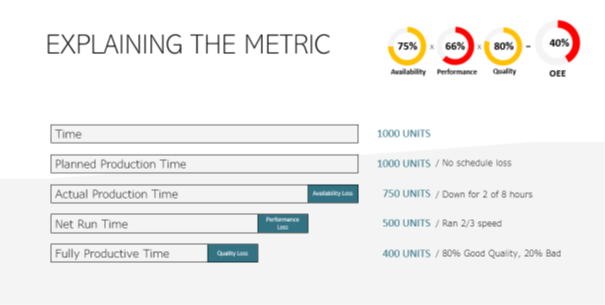Embarking on an Industry 4.0 Journey with Grantek’s OEE Accelerator
June 2, 2022

Before diving into our OEE Accelerator, let’s first discuss performance monitoring.
Performance Monitoring in the Context of Industry 4.0
Industry 4.0 promises manufacturers predictable, adaptable operations that self-organize to deliver high-quality products with the most efficient resources. Attaining that vision is a journey with several intermediate steps that each provide incremental value and improvement to manufacturing operations. The Acatech Industrie 4.0 Maturity Index1 describes stages of Visibility and Transparency as foundational building blocks to achieving Predictive Capacity and Adaptability.
Click here to download the Whitepaper.

While most manufacturers have ambitions to adopt the principles of Industry 4.0, the vast majority are still working on the Digitalization, Visibility, and Transparency stages2. These stages are logical precursors to more advanced technology adoption: to achieve self-optimizing processes we first need to connect to and digitize our data, visualize what is happening in real-time, and understand the litany of interdependencies that make up manufacturing operations.

Performance monitoring software is a critical piece to the Visibility and Transparency stages of the Industry 4.0 journey. Performance monitoring means being able to see how all the stages of manufacturing operations are performing in real-time.
At a high-level, performance monitoring solutions should provide clear insights into:
1. What each manufacturing asset is working on now, and scheduled to work on in the future
2. The status of and progress against active production orders
3. Anything that is preventing manufacturing operations from achieving their targets
These insights can be provided at a workcell, production line, or facility-level, and can be analyzed in the context of what materials are being produced and who is operating the line. Visit: https://grantek.com/industry-4-0-consulting-for-life-sciences/, to learn more about Performance Management concepts, ISA-953 and its component parts thoroughly break-down manufacturing operations into Performance, Quality, Inventory, and Maintenance management and their unique activities.
OEE as a Performance Monitoring Tool
Overall Equipment Effectiveness, or OEE, is one of the most common metrics for performance monitoring. The OEE calculation itself provides valuable insights into the efficiency of a production asset, providing an overall, percent-based score for overall asset efficiency and breaking-down that calculation into Availability, Throughput, and Quality components.
Most OEE software goes beyond the core calculation to provide additional insights that provide a more comprehensive performance monitoring tool: namely scheduling and downtime analysis. Understanding what materials are running and scheduled to-be-run on a production line helps put OEE scores into context, and it is common to see different OEE scores depending on the product being run at the time.
Downtime tracking and analysis is another key component of performance monitoring software. It is not enough to simply know if an asset is running or not, it is important to understand what caused a piece of equipment to experience unplanned downtime.
Manufacturers who use OEE as a performance monitoring tool can expect real-time information on what their manufacturing assets are working on and how well they are performing their work. They can easily identify any bottlenecks and where they may be underperforming. These manufacturers understand whether their overall efficiency is being affected by issues with availability, throughput, or quality. They will also have the tools to dive in deeper and better understand the factors that lead to disappointing or exceptional performance.
What is OEE?
OEE measures asset utilization by representing the total percentage of time that an asset was truly and fully productive. OEE is calculated by multiplying its three components of Availability, Performance, and Quality together (also referred to as A, P, and Q).
1. Availability refers to the uptime of the asset. Anytime that the asset is running and capable of producing product counts as Available time. Availability losses can come from unplanned downtime, unplanned breaks, or staffing shortages.
2. Performance refers to the speed of the asset. An asset that is Performing at 100% is producing as much product as it can in the time that it is running. Performance losses come from reduced line speeds and low run rates.
3. Quality refers to the usable products made by the asset. A 100% Quality score indicates that every part produced by the asset is usable and sellable. Quality losses come from faulty parts that need to be scrapped or reworked.
𝑂𝐸𝐸=𝐴𝑣𝑎𝑖𝑙𝑎𝑏𝑖𝑙𝑖𝑡𝑦 𝑥 𝑃𝑒𝑟𝑓𝑜𝑟𝑚𝑎𝑛𝑐𝑒 𝑥 𝑄𝑢𝑎𝑙𝑖𝑡𝑦
𝑂𝐸𝐸=𝐴𝑐𝑡𝑢𝑎𝑙 𝑅𝑢𝑛𝑡𝑖𝑚𝑒𝑃𝑙𝑎𝑛𝑛𝑒𝑑 𝑃𝑟𝑜𝑑𝑢𝑐𝑡𝑖𝑜𝑛 𝑇𝑖𝑚𝑒 𝑥𝐴𝑐𝑡𝑢𝑎𝑙 𝑅𝑎𝑡𝑒𝐼𝑑𝑒𝑎𝑙 𝑅𝑎𝑡𝑒𝑥𝐺𝑜𝑜𝑑 𝑃𝑎𝑟𝑡𝑠𝑇𝑜𝑡𝑎𝑙 𝑃𝑎𝑟𝑡𝑠

One notable, similar metric to OEE is TEEP, or Total Effective Equipment Performance. OEE does not count Schedule Losses against the efficiency score for the asset, but TEEP does. In practice, this means that if an asset is not scheduled to run for a time due to things like lack of demand or scheduled maintenance, that will not affect the OEE score of the asset. TEEP does include this Schedule Loss in its evaluation of the asset, so a 100% TEEP score requires the asset to be running 24/7/365 and to have a 100% OEE score. Most OEE systems can also calculate TEEP, and manufacturers should pick the metric that best fits their business objectives.
Example: Calculating OEE in Practice
Situation
A production line is scheduled for a single production run of 1,000 units in an 8-hour shift, which is the maximum capacity of the line (i.e. 1,000 units in 8 hours is the maximum throughput of the line).
Calculating OEE
Let’s consider a few different losses we can experience during the shift and see how that affects the line’s OEE score. We will be calculating OEE for the shift (OEE is always calculated over a specific timeframe).
We are scheduled to run for all 8-hours of the 8-hour shift, so our Planned Production Time is 8 hours and there is no Schedule Loss. Schedule Loss would not affect our OEE, but it would affect TEEP. Since we have no Schedule Loss our OEE and TEEP would be the same in this scenario.

Availability Loss: Of the 8 hours we were scheduled to run, we were down for 2 of those hours due to a mechanical fault on the line. This means that our Availability score is 75% (6 hours of Actual Runtime / 8 hours of Planned Production Time) and even if the rest of the shift is perfect, the most we could hope to produce is 750 Units of our planned 1,000.
Performance Loss: While our line can make 1,000 units in 8 hours (125 units/hr.), our operations team ended up running the line at 83 units/hr., or about 2/3 of the ideal speed. That means our Performance score is 66% (83 units/hr. / 125 units/hr.). Paired with our Availability loss, the target total production quantity for the shift is now 500 units if we have a perfect Quality run.
Quality Loss: Let’s say that we had to scrap 100 units due to Quality issues during the run, meaning that we only had 400 good parts during this shift. This means our Quality score is 66% (100 scrap parts / 500 total parts).
Our total OEE for the shift can now be calculated:
𝑂𝐸𝐸=𝐴𝑐𝑡𝑢𝑎𝑙 𝑅𝑢𝑛𝑡𝑖𝑚𝑒𝑃𝑙𝑎𝑛𝑛𝑒𝑑 𝑃𝑟𝑜𝑑𝑢𝑐𝑡𝑖𝑜𝑛 𝑇𝑖𝑚𝑒 𝑥𝐴𝑐𝑡𝑢𝑎𝑙 𝑅𝑎𝑡𝑒𝐼𝑑𝑒𝑎𝑙 𝑅𝑎𝑡𝑒𝑥𝐺𝑜𝑜𝑑 𝑃𝑎𝑟𝑡𝑠𝑇𝑜𝑡𝑎𝑙 𝑃𝑎𝑟𝑡𝑠 𝑂𝐸𝐸=6 ℎ𝑜𝑢𝑟𝑠8 ℎ𝑜𝑢𝑟𝑠 𝑥83 𝑢𝑛𝑖𝑡𝑠 𝑝𝑒𝑟 ℎ𝑜𝑢𝑟125 𝑢𝑛𝑖𝑡𝑠 𝑝𝑒𝑟 ℎ𝑜𝑢𝑟𝑥400 𝑝𝑎𝑟𝑡𝑠500 𝑝𝑎𝑟𝑡𝑠 𝑂𝐸𝐸=75% 𝑥 66% 𝑥 80%=𝟒𝟎%
While our individual scores for Availability, Performance, and Quality may seem acceptable, the combined effect of these losses has severely impacted our overall efficiency of the asset, which was only 40% productive.
Grantek’s OEE Accelerator
Grantek has designed our OEE Accelerator Solution to get manufacturers up-and-running with a comprehensive and accessible Performance Monitoring system. The OEE Accelerator is designed to deliver what every manufacturer needs from their OEE system out-of-the-box while enabling flexibility to adapt to custom requirements and scalability across the entire plant, business unit, and enterprise.
The OEE Accelerator is built using Inductive Automation’s Ignition SCADA platform and Sepasoft’s OEE and Downtime Tracking Manufacturing Execution System (MES) module for Ignition. Ignition is one of the fastest-growing SCADA platforms in manufacturing and provides a platform for data collection, organization, historization, and visualization. Sepasoft’s MES modules for Ignition expand the SCADA platform’s capabilities to include Manufacturing Operations Management functions like production scheduling, traceability, quality management, and OEE. Grantek’s OEE Accelerator is built on these platforms because they align with our vision for advanced, affordable, and extendable MES technology for manufacturers.
Grantek’s OEE Accelerator leverages core functionality of Ignition and the Sepasoft OEE and Downtime Tracking module whenever possible so that our solution stays up-to-date and supportable. While many of the core functions of an OEE system come from the Sepasoft module itself, Grantek’s Accelerator comes ready-to-deploy with the screens and functionality we know are most useful for manufacturers on Day 1. It is also specifically designed with scalability and flexibility in-mind so that the solution is ready for rollouts and customizations when your business is ready to expand its performance monitoring initiative or explore new MES functions like traceability.
The OEE Accelerator provides the following Performance Management functions:
1. OEE Dashboards to communicate critical data including total OEE, Availability, Performance, and Quality for a machine, line, area, and facility.
2. OEE Reports to communicate performance summary data over a specified period.
3. Scorecards to analyze additional performance data like parts produced per hour, hourly OEE scores, and top downtime reasons.
4. A downtime analysis portal to drill-down into downtime reasons and state changes by equipment, production order, or product; exportable to CSV for external analysis.
5. Product Scheduling and Control to define, schedule, run, and manage work orders.
6. Downtime management to manually enter, split, re-code, and comment on downtime events.
See the OEE Accelerator Brochure for more detail on what is included in the latest version of the OEE Accelerator [https://grantek.com/wp-content/uploads/2022/05/2022OEEAccelerator.pdf].
Grantek’s OEE Accelerator and Agile MES Methodology
Based on our experience over the past two decades, Grantek has committed to an Agile-inspired methodology for designing and delivering MES solutions for our customers. We found that using traditional, waterfall-style project management techniques led to projects with a huge time-gap between requirements-gathering activities and MES-deployment activities. This method led to projects where the delivered solution was not able to keep-up with the shifting priorities of the business, increasing the risk of overly complex designs, unused functionality, and frustrated stakeholders.
While waterfall project management may work for large equipment purchases or when building new plants, software projects like performance management and MES are best suited for an Agile approach which emphasizes collaboration between end-users and developers to deliver ongoing and incremental value to the solution. In Agile, we define a Minimum Viable Product (MVP) or Proof of Concept (POC) that provides immediate value to the business and does not require months of development time. That MVP then serves as the baseline for regular improvement and innovation as new requirements are identified, prioritized, developed, and implemented. This allows more flexibility for end-users to find the highest-value opportunities to improve their workflow, and it produces tangible results for the business from Day 1.
The OEE Accelerator is a frequent starting point for a MES MVP. A successful OEE Accelerator implementation will prove that the MES can connect to and analyze critical production data and that this information can be shared with end-users through OEE dashboards. It provides immediate value in analyzing the efficiency of manufacturing assets, providing insights into causes of downtime, and implementing a work order management and scheduling system. It can also be adapted to new processes and machines, expanded to incorporate business-specific requirements like ERP-connectivity, and rolled-out to multiple machines, lines, and facilities. Grantek’s OEE Accelerator can also provide a foundation for other Sepasoft MES modules like Track and Trace, SPC, and Batch.

Performance Monitoring for Continuous Improvement
It is important to remember that Performance Monitoring solutions like Grantek’s OEE Accelerator are just the beginning of a Continuous Improvement and Smart Manufacturing journey. Installing a Performance Monitoring system to better understand how manufacturing assets are performing and where they can improve does not in itself improve those machines and processes.
Performance Monitoring systems like the OEE Accelerator are best used as tools in an ongoing continuous improvement initiative. Manufacturers need to make sure there are specialists dedicated to using these systems to analyze data, recommend improvements, run experiments, and challenge assumptions. These continuous improvement teams need access to as much data as possible so they can find optimal value-add solutions, and Performance Monitoring and downtime analysis tools are a great place to start.
Conclusion
Digital Transformation, Industry 4.0, and Smart Manufacturing are broad and complex concepts that are simultaneously critical to our business and challenging to implement. Many manufacturers find themselves stuck in planning-perpetuity: constantly creating and iterating on plans to adopt Industry 4.0 and not getting to the point where they implement new technologies and realize operational improvements.
While Industry 4.0 strategies and roadmaps are critical to a successful journey, so are solutions like the OEE Accelerator that can be deployed quickly to demonstrate results. The best Industry 4.0 roadmaps balance short, medium, and long-term initiatives with various levels of risk and anticipated rewards. Grantek’s OEE Accelerator delivers a low-risk proof of concept with fast time-to-value, while also providing a foundation for long-term Smart Manufacturing solutions.
